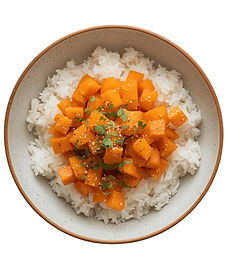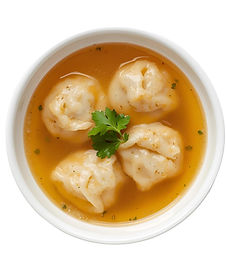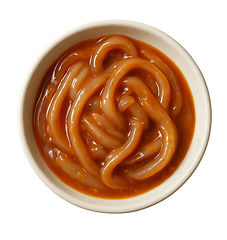ホーム
制度
健康
栄養
FOOD GUIDELINES
ICHIJU SANSAI

Makanan yang disedikan oleh Eiken menganut pada konsep Ichiju Sansai. Ichiju Sansai (一汁三菜) adalah konsep dasar dalam tradisi kuliner Jepang yang berarti "satu sup dan tiga lauk". Istilah ini merujuk pada komposisi ideal dari satu hidangan makan lengkap yang seimbang, terdiri dari elemen-elemen berikut:
-
Satu sup (ichiju / 一汁): Biasanya berupa sup miso, tetapi bisa juga berupa jenis sup lain, seperti sup kaldu atau sup berbahan dasar sayuran. Sup ini berfungsi untuk memberikan cairan, rasa hangat, serta gizi tambahan
-
Satu lauk utama (shusai / 主菜): Lauk utama ini umumnya berupa protein, seperti ikan, daging, tahu, atau tempe. Dalam masakan tradisional Jepang, ikan sering menjadi pilihan utama, baik dalam bentuk panggang, goreng, maupun mentah seperti sashimi.
-
Dua lauk pendamping (fukusai / 副菜):Lauk pendamping biasanya adalah sayuran atau hidangan nabati lain yang diolah dengan teknik seperti direbus, dikukus, atau ditumis. Contohnya termasuk sayuran yang ditumis, acar (tsukemono), atau rebusan berbahan dasar sayur dan rumput laut.
-
Nasi (gohan / ご飯): Walaupun tidak termasuk dalam istilah "ichiju sansai", nasi adalah elemen utama dari hidangan tradisional Jepang dan selalu disajikan sebagai pendamping.
Ichiju Sansai berfokus pada keseimbangan nutrisi dan estetika dalam penyajian makanan. Setiap elemen dari hidangan ini bertujuan untuk menciptakan variasi rasa, tekstur, dan warna, sekaligus memberikan gizi yang seimbang antara karbohidrat, protein, lemak, serat, vitamin, dan mineral. Selain itu, makanan dalam konsep ini biasanya diolah dengan cara sederhana untuk mempertahankan rasa alami bahan-bahan, selaras dengan prinsip harmoni dengan alam yang dipegang kuat dalam budaya Jepang.
Food Guide Spinning Top

Untuk dapat memenuhi kecukupan nutrisi bagi warga Mahoutokor JP, Eiken mengikuti panduan nutrisi yang dikembangkan oleh pemerintah Jepang.
Piramida makanan Jepang (Japanese Food Guide Spinning Top atau "食事バランスガイド") adalah panduan nutrisi untuk mendorong pola makan sehat. Piramida ini lebih berbentuk seperti gasing, yang menunjukkan keseimbangan antara berbagai kelompok makanan dan pentingnya aktivitas fisik. Piramida ini berbeda dari piramida makanan Barat dengan beberapa penyesuaian berdasarkan tradisi makan di Jepang.
Elemen Piramida Makanan Jepang:
-
Makanan Pokok (nasi, roti, mi, pasta): Terletak di bagian terluas (atas), ini adalah sumber utama energi. Karbohidrat seperti nasi dan mi adalah komponen penting dalam diet Jepang. Dianjurkan untuk mengonsumsi 5-7 porsi sehari.
-
Sayur-sayuran: Ada di bagian kedua setelah karbohidrat, dengan anjuran 5-6 porsi sehari. Sayuran memberikan serat, vitamin, dan mineral penting.
-
Daging, Ikan, Telur, Kacang-kacangan: Sumber protein yang mencakup ikan, daging tanpa lemak, telur, dan produk berbasis kacang seperti tahu. Disarankan 3-5 porsi sehari.
-
Susu dan Produk Olahannya: Di bagian selanjutnya, dengan rekomendasi 2 porsi sehari. Produk ini penting untuk asupan kalsium.
-
Buah-buahan: Buah direkomendasikan sebanyak 2 porsi sehari untuk sumber vitamin dan mineral.
-
Minyak dan Lemak: Terletak di bagian atas dan kecil dari piramida, menunjukkan bahwa konsumsi minyak dan lemak harus dibatasi.
-
Air dan Teh: Konsumsi air atau teh hijau yang bebas kalori juga sangat dianjurkan. Biasanya disarankan 6-8 gelas sehari.
-
Olahraga: Terdapat gambar orang berlari di bagian atas piramida, menekankan pentingnya aktivitas fisik dalam menjaga kesehatan secara keseluruhan.
MENU
GOHAN NO SHURUI - ご飯の種類
ANEKA NASI
Shake Gohan (鮭ご飯)
This comforting rice dish is served with tender pieces of salmon, creating a balance of delicate flavor and hearty texture. At times, it is finished with a sprinkle of toasted sesame seeds or thinly sliced scallions, adding fragrance and a subtle crunch. The salmon enriches the rice with its natural savoriness, while the garnishes bring freshness and depth. Simple yet elegant, it is a dish that feels both nourishing and refined, perfect for everyday meals or a special table setting.
%20-%20Shake%20Gohan.jpg)
%20-%20Satsumaimo%20Gohan.jpg)
Satsumaimo Gohan (さつまいもご飯)
Steamed rice paired with cubes of Japanese sweet potato (satsumaimo), offering a gentle harmony of soft textures and natural sweetness. The tender potatoes melt slightly into the grains, giving each bite a comforting depth. A simple yet heartwarming dish, it carries the warmth of home and the quiet elegance of tradition.
Tiānjīn Fàn (天津饭)
Fluffy white rice is topped with a thick omelet, folded to hold a savory filling of crab or mixed vegetables. The dish is then generously draped in a glossy sweet-and-sour sauce, a hallmark of Chinese flavors. The sauce seeps into the omelet and rice beneath, creating layers of taste, tangy, rich, and deeply satisfying. Both comforting and indulgent, it’s a dish that brings warmth to everyday dining while carrying the flair of classic Chinese cooking.
%20-%20Ti%C4%81nj%C4%ABn%20F%C3%A0n.jpg)
%20-%20Xi%C4%81ngg%C7%8Eng%20Ch%C7%8Eomi%C3%A0n.jpg)
Xiānggǎng Chǎomiàn (香港炒面)
Hong Kong–style fried noodles feature thin egg noodles pan-fried until golden and crisp, then tossed in a savory sauce. The contrast between the crunchy edges and tender strands creates a satisfying texture, while the sauce coats every bite with rich, umami flavor. Light yet flavorful, it’s a dish that showcases the charm of Cantonese cooking.
SHIRU NO SHURUI - 汁の種類
ANEKA SUP
Ushio Jiru (潮汁)
This clear soup is made with fresh fish, gently simmered to release its natural sweetness. Seasoned simply with salt and a touch of sake (non-alcoholic), it highlights purity and balance. The broth is light yet flavorful, offering warmth and subtle elegance in every sip.
%20-%20Ushio%20Jiru.jpg)
%20-%20Osuimono.jpg)
Osuimono (お吸い物)
An elegant clear soup crafted from delicate dashi, often reserved for formal occasions. Within the refined broth may rest shrimp, tender fish, or artfully cut seasonal vegetables. Each ingredient is chosen for both flavor and beauty, making the dish a gentle harmony of taste and presentation.
Húntun Tāng (馄饨汤)
A delicate clear soup featuring wontons filled with succulent shrimp. The light broth enhances the sweetness of the seafood, while the soft dumpling wrappers offer a tender bite. Simple yet comforting, it’s a dish that soothes the palate with every spoonful.
%20-%20H%C3%BAntun%20T%C4%81ng.jpg)
%20-%20Su%C4%81n%20L%C3%A0%20T%C4%81ng.jpg)
Suān Là Tāng (酸辣汤
This classic Sichuan hot and sour soup is a balance of sharp vinegar and warming black pepper heat. Silken tofu, earthy mushrooms, and tender bamboo shoots enrich the broth, creating layers of texture. Spicy, tangy, and aromatic, it’s a dish that awakens the senses and embodies Sichuan’s vibrant flavors.
SHUSAI - 主菜
LAUK UTAMA
Menchi Katsu (メンチカツ)
Japanese-style breaded and deep-fried patty made from minced meat, often a blend of beef and pork. Crispy on the outside yet juicy within, it delivers a hearty bite filled with rich, savory flavor. Commonly served with shredded cabbage and tangy sauce.
%20-%20Menchi%20Katsu.jpg)
%20-%20Buri%20no%20Teriyaki.jpg)
Buri no Teriyaki (鰤の照り焼き)
A classic Japanese hot pot, features thin slices of tender beef simmered with vegetables, tofu, and noodles in a sweet-savory broth. Just before eating, the hot beef is dipped into fresh beaten egg, coating each bite with a silky, rich layer that balances the broth’s depth with gentle smoothness.
Shabu-shabu (しゃぶしゃぶ)
Thinly sliced meat, quickly swished in hot broth until just cooked, then enjoyed with dipping sauces such as bright, citrusy ponzu or nutty sesame goma. Light yet flavorful, the tender meat absorbs the sauces beautifully, making each bite fresh, delicate, and satisfying.
%20-%20Shabu-shabu.jpg)
%20-%20L%C3%A0z%C7%90%20J%C4%AB.jpg)
Làzǐ Jī (辣子鸡)
Crispy fried chicken tossed with dried chilies and tongue-tingling Sichuan peppercorns. The crackling texture of the chicken meets layers of heat, fiery, numbing, and deeply aromatic. Spicy and addictive, it’s a dish that delivers the signature punch of Sichuan cooking.
Pángxiè Fěnsī Bāo (螃蟹粉丝煲)
Crab simmered with vermicelli noodles in a claypot, allowing the rich seafood flavors to soak deep into the tender strands. The claypot locks in heat and aroma, creating a dish that is both hearty and fragrant, with the natural sweetness of crab mingling beautifully with the noodles.
%20-%20P%C3%A1ngxi%C3%A8%20F%C4%9Bns%C4%AB%20B%C4%81o.jpg)
%20-%20G%C5%8Dngb%C7%8Eo%20J%C4%ABd%C4%ABng.jpg)
Gōngbǎo Jīdīng (宫保鸡丁)
A signature Sichuan dish of diced chicken stir-fried with roasted peanuts, dried chilies, and a glossy sauce that balances savory, spicy, and sweet notes. The tender chicken pairs with the crunch of peanuts and the heat of chilies.
FUKUSAI - 副菜
LAUK PENDAMPING
Ika no Shiokara (いかの塩辛)
Salt-fermented squid, a traditional delicacy known for its bold, savory depth. The fermentation process intensifies the natural brininess of the squid, creating a rich umami flavor with a pleasantly pungent aroma. Often enjoyed in small portions, it pairs beautifully with plain rice, bringing a burst of character to the table.”
%20-%20Ika%20no%20Shiokara.jpg)
%20-%20Hiyayakko.jpg)
Hiyayakko (冷奴)
Chilled tofu served with a drizzle of soy sauce, fragrant ginger, and a sprinkle of fresh scallions. The soft, silky texture of the tofu contrasts with the zing of ginger and the brightness of the scallions, creating a simple yet refreshing dish that highlights clean flavors.
Kabocha no Nimono (南瓜の煮物)
Steamed pumpkin prepared to bring out its natural sweetness, gently seasoned with a touch of savory flavor. Soft and comforting, the dish balances sweet and salty notes, making it both nourishing and satisfying, a simple classic that warms the table.
%20-%20Kabocha%20no%20Nimono.jpg)
%20-%20Ch%C7%8Eo%20D%C3%A0n%20F%C4%81nqi%C3%A9.jpg)
Chǎo Dàn Fānqié (炒蛋番茄)
Scrambled eggs stir-fried with ripe tomatoes, creating a balance of savory richness and refreshing tang. The eggs are soft and comforting, while the tomatoes add a burst of juiciness, making this simple dish both hearty and vibrant.
Suànróng Xīlánhuā (蒜蓉西兰花)
Stir-fried broccoli with garlic, a simple dish that highlights freshness and aroma. The broccoli stays tender yet slightly crisp, while the garlic infuses it with a savory fragrance. Light, wholesome, and satisfying, it’s a classic that brings brightness to any meal.
%20-%20Su%C3%A0nr%C3%B3ng%20X%C4%ABl%C3%A1nhu%C4%81.jpg)
%20-%20J%C4%ABd%C3%A0n%20Ni%C3%BAr%C3%B2u%20Ch%C7%8Eo.jpg)
Jīdàn Niúròu Chǎo (鸡蛋牛肉炒)
A light dish of softly cooked eggs combined with thin slices of beef. The richness of the meat blends with the delicate texture of the eggs, creating a savory harmony that is both simple and satisfying. Often served as a side, it adds warmth and depth to the meal.
KUCHINAOSHI - 口直し
PENCUCI MULUT
Annin Dōfu (杏仁豆腐)
Japanese-style almond pudding, celebrated for its delicate texture and light sweetness. Silky and smooth, it melts gently on the palate, while the subtle almond aroma lingers with each bite. A refreshing dessert that feels both comforting and refined.
%20-%20Annin%20D%C5%8Dfu.jpg)
%20-%20Zenzai.jpg)
Zenzai (ぜんざい
A sweet red bean soup served with soft, chewy mochi. The beans are simmered until tender, releasing a natural earthy sweetness that blends into the gentle warmth of the broth. The mochi adds a satisfying texture, making the dish both comforting and nostalgic.
Dàntà (蛋挞)
Mini egg tarts with a delicate pastry shell and smooth custard filling. Sweet yet light, they offer a gentle balance of crispness and creaminess in every bite. Perfect as a small treat, they bring comfort without being heavy.
%20-%20D%C3%A0nt%C3%A0.jpg)
%20-%20Ch%C3%A9ngzi.jpg)
Chéngzi (橙子)
Juicy mandarin orange segments, bursting with natural sweetness and a hint of citrus tang. Their bright flavor and refreshing texture make them a light, wholesome treat, perfect as a palate cleanser or a simple finish to any meal.
NOMIMONO - 飲み物
MINUMAN
Nihoncha-wari (日本茶割り)
A refreshing blend of green tea and non-alcoholic shōchū, offering a balance of earthy tea notes and smooth, mellow depth. Light and crisp, it’s a drink that feels both calming and invigorating.
%20-%20Nihoncha-wari.jpg)
%20-%20Ryokucha.jpg)
Ryokucha (緑茶)
A classic Japanese green tea, enjoyed either hot for soothing warmth or chilled for refreshing crispness. Its earthy aroma and gentle bitterness bring a sense of calm and clarity, making it a timeless companion for any moment of the day.
Bīngtáng Xuělí (冰糖雪梨)
A cooling drink made from pears simmered with rock sugar, releasing a natural sweetness and gentle fragrance. Light and soothing, it offers a crisp refreshment that quenches thirst while leaving a smooth, calming finish.
%20-%20B%C4%ABngt%C3%A1ng%20Xu%C4%9Bl%C3%AD.jpg)
%20-%20B%C4%ABngf%C4%9Bn.jpg)
Bīngfěn (冰粉)
A chilled drink featuring soft jelly made from bean flour, served in a lightly sweet syrup. Cool and refreshing, it offers a smooth texture with a gentle sweetness, making it a simple yet delightful treat on warm days.
FOOD PICKUP

Pelaporan pengambilan makanan dilakukan dengan plotting 1x/minggu dengan ketentuan:
-
Berisi minimal 5 replies (tidak termasuk head plot)
-
Menggambarkan kegiatan selama mengambil makan setiap harinya (misalnya, mengantre, memilih makan, makan bersama teman, dll). Apabila melakukan plot bersama teman, maka ada penambahan minimal replies +2/orang. (Apabila berdua menjadi min. 7 replies, apabila bertiga menjadi min. 9 replies, dst.)
-
Harus memilih 1 jenis nasi, 1 jenis sup, 1 lauk utama, 2 lauk pendamping, serta 1 pencuci mulut dan 1 minuman. Air mineral sudah termasuk dalam menu sehingga wajib disertakan dalam plot.
Head Plot (Opsional)
1. Tuliskan rentang tanggal pengambilan makanan
2. Nama lengkap dan ID
3. Dapat berupa gambar atau tulisan
Contoh Plot
Pengambilan Makanan
Periode 14-20 Oktober 2024
Kikuzawa Yune - 2405JM004
----------------------------------------------------------------------------------------------------
Yūne sudah bertekad untuk menurunkan berat badan. Dia mulai membatasi asupan yang masuk ke tubuhnya. Beruntung, Eiken menyediakan diet rendah kalori yang sangat membantu Yūne dalam menghitung asupan dirinya.
Hari ini, puan itu menjatuhkan pilihan pada Genmai daripada Sushi meshi untuk nasi. Gadis itu kemudian terdiam, bimbang pada pilihan antara Miso Soup atau Suimono. Setelah menimbang, dia pun memilih untuk mengambil Miso Soup.
Sejak kemarin, dia ingin sekali memakan ikan dan beruntungnya kali ini Yakizakana ada di dalam pilihan lauk utama. Untuk melengkapi asupannya, Gobo no Kinpira dan Tsukune menjadi lauk pendamping yang dia pilih. Tak lupa ia mengambil hidangan pencuci mulut yakni potongan buah Jeruk Meiken dan Apel Fuji.
Berbekal nampan yang telah terisi penuh juga segelas matcha latte dan air mineral, Yūne pun berjalan mencari tempat duduk kosong di area makan ini. Puan itu beberapa kali berpapasan dengan rekannya yang juga sedang menikmati makanan. Yūne pun memberikan senyuman dan sesekali sapaan.
Setelah melihat spot kosong yang menurutnya cukup nyaman, Yūne kemudian menikmati makanannya dengan hikmat. "いただきます!" seru puan itu sebelum satu suapan memasuki mulutnya.
Selesai.